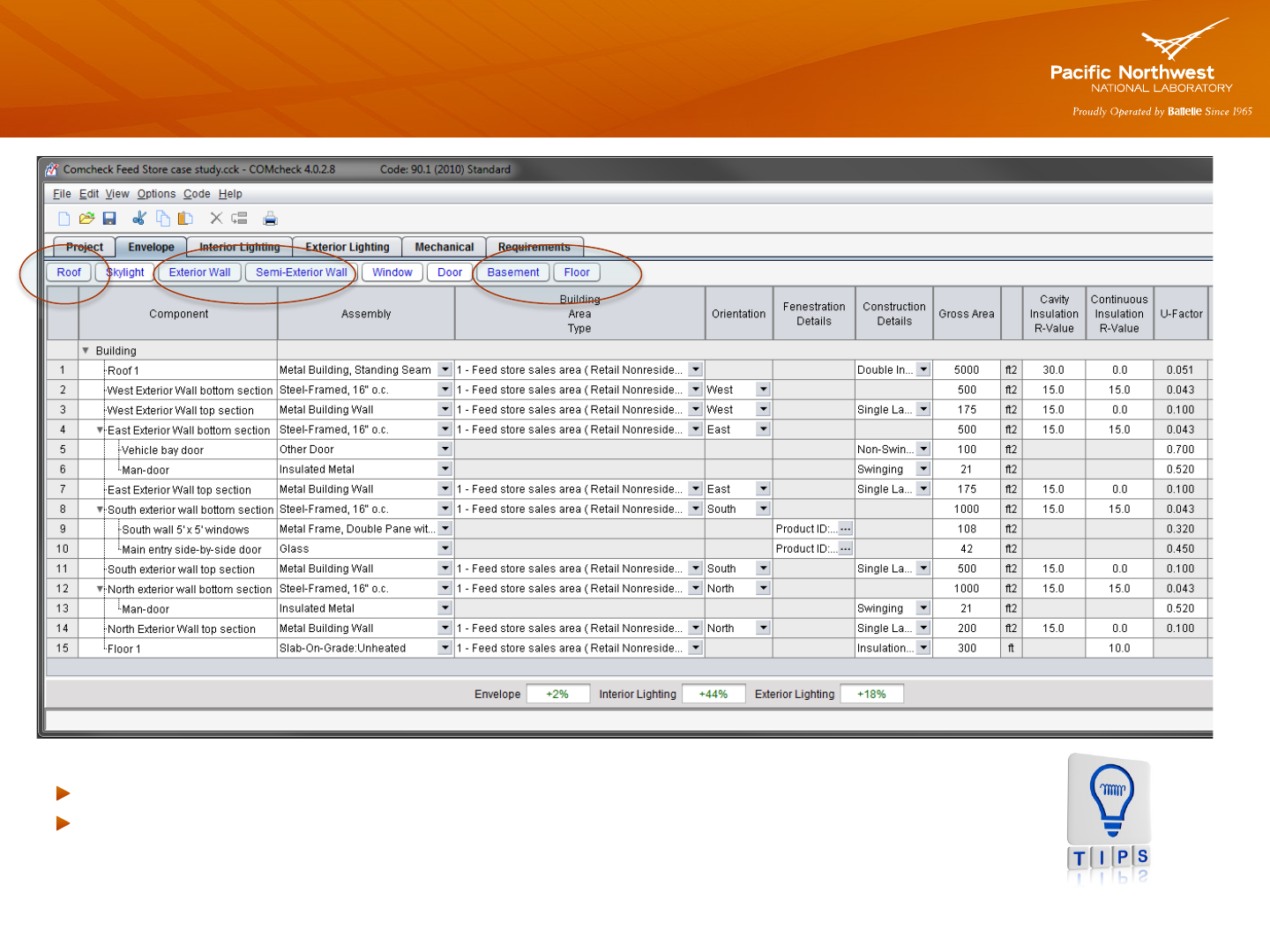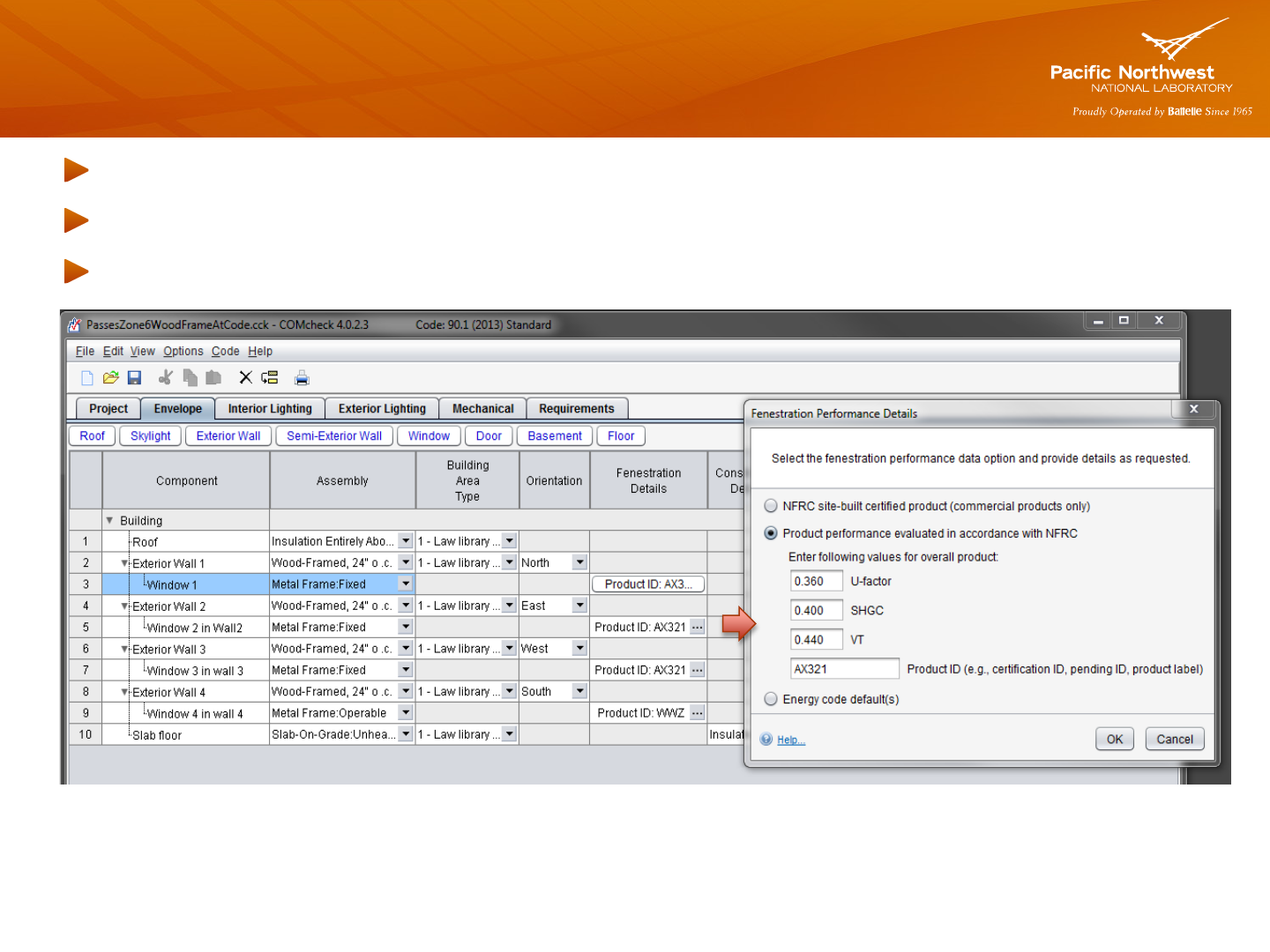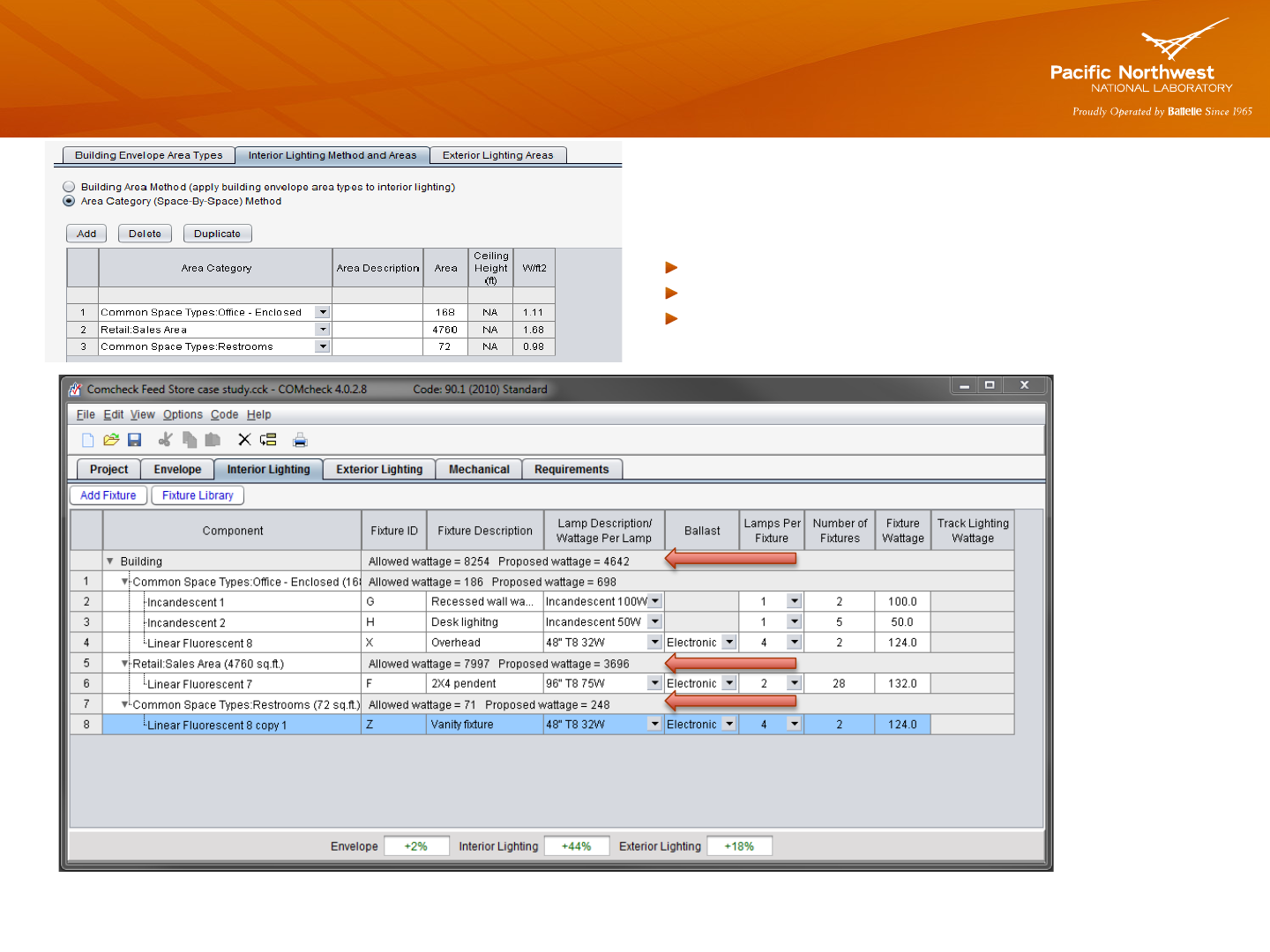
COMcheck
TM
Basics
1
PNNL-SA-
PAM COLE, PACIFIC NORTHWEST NATIONAL LABORATORY
BOB SCHULTZ, PACIFIC NORTHWEST NATIONAL LABORATORY
U.S. Department of Energy Building Energy Codes Program
Energy Codes Commentator Webinar Series
AIA Provider #: I014
AIA Course #: BECPWSJ16
June 9, 2016

Course Description and
Learning Objectives
Basics of using the COMcheck software, reviewing
generated compliance reports, and the latest and greatest
new features.
1. Obtain an overview of the basic functions and how
COMcheck calculates compliance for the building
envelope, interior and exterior lighting.
2. Be able to identify the construction specifications
needed to complete a compliance calculation in
the software.
3.
Learn how to enter the building envelope, lighting, and
mechanical components into the software.
4. Understand how the compliance reports are created
and what they entail.
Learning Objectives:

CheckTools Current Use Scenario
3
Building Energy Codes Program
BECP Tools used only during “Demonstrate Compliance” Stage
• Collect Data
• Prepare Input
• Check Compliance
• Generate Compliance
Report
Demonstrate
Compliance
• Review Software Input
• Check Compliance
Results
• Review Mandatory
Requirements
Plan Review
• Verify compliance of
inspection checklist
items
• Approve compliance
Field
Inspection
Builder
Architect
Designer
Plan Reviewer Field Inspector
Paper/PDF
Paper/PDF

COMcheck Compliance Methods
4
Building Energy Codes Program
Mandatory
Provisions
(required for most
compliance options)
Building System Compliance Options
Energy Code
Compliance
Prescriptive
Option
Energy Cost
Budget:
Performance
Simulation
Trade Off
Option
Envelope
HVAC
Lighting
SWH
Power
Other

Envelope Trade-Off Methods (cont.)
5
Building Energy Codes Program
ASHRAE 90.1 (Pre-2013) Normative Appendix C
Methodology for Building Envelope Trade-Off Option
90.1-2007/2010
2009/2012 IECC
ASHRAE 90.1-2013 Appendix C has limited performance
method (EnergyPlus)
2015 IECC Component Performance Alternative (Total UA)

Project Types
New Construction:
Trade-off compliance method
Prescriptive – Oregon only
Addition
Trade-off compliance method
Prescriptive – Oregon only
Alteration
Prescriptive compliance
6
Building Energy Codes Program

Lighting Compliance Methods
Mandatory requirements: Controls, Switching
Interior/Exterior lighting power requirements
Complies if total connected power <= lighting power allowance
7
Proposed Wattage
Allowed
Wattage
≤
Allowed Wattage
Building Energy Codes Program

Mechanical/Service Hot Water Compliance
Efficiency requirements
Economizer requirements
Fan Power Limitation
Mandatory requirements
No compliance metric available
8
Allowed
Wattage
Allowed Wattage
Building Energy Codes Program

COMcheck Project Specification Steps
9
Project
Building
Envelope
Components
Lighting
Mechanical
Requirements/
View/Print/
Save
Building Energy Codes Program

Info You’ll Need
Energy Code
Builder and project location
Area take-offs for envelope assemblies
Insulation R-values, fenestration performance data
Lighting fixture details
Heating and cooling system details
Service water heating details
10
Building Energy Codes Program

www.energycodes.gov
11
Building Energy Codes Program

12
COMcheck
Building Energy Codes Program

Can exchange files between
desktop and web
Log in to web
My Projects
13
Desktop/Web Data Exchange
Building Energy Codes Program
Upload from desktop to web account
Download from web
account to desktop

COMcheck Basics: Color cues and feedback
14 Building Energy Codes Program
Red
Green
Blue
Status bar
Compliance bar

COMcheck Basics: Menus and Toolbars
15 Building Energy Codes Program

COMcheck Basics: Options Menu
Comments
Orientation (code dependent)
Projection Factor
Visible Transmittance
Exemptions/Allowances
16
Building Energy Codes Program
Projection Factor

Project Screen
17
Building Energy Codes Program

Project: Code and Location
Appropriate Code
18
Building Energy Codes Program
Location

Project: Project Type
New Construction
Addition
Alteration
19
Building Energy Codes Program

Project: Alteration project type explained
Projects involve changes to or replacement of
Existing building components that are part of building envelope
Lighting, heating, ventilating, air conditioning, and water-heating
equipment
Specify only those envelope components, lighting fixtures, or
mechanical systems/equipment that will exist upon completion of the
project
Alteration detail dialogs
Specify exemptions if applicable
Additional qualifications may be required (e.g., Window/wall ratio)
Compliance shown as Pass/Fail for Envelope and Lighting
20
Building Energy Codes Program

Compliance Options (IECC only)
Efficiency Options
High performance power (2012/2015)
Reduced lighting power (2012/2015)
On-site renewable energy (2012/2015)
High performance SWH (2015)
Enhanced interior lighting controls (2015)
Dedicated outdoor air system (2015)
21
Building Energy Codes Program
Air Barrier Options (IECC 2012+, climate zone dependent)
Air barrier permeability
Assembly permeability
Air leakage test

Project: Project Details
Optional
Sections
Title/Site/Permit
Owner/Agent
Designer/Contractor
Included on report
22
Building Energy Codes Program

Project: Building Envelope Area Types
Primarily impacts envelope compliance
Whole building types that describe the envelope (separating
conditioned and unconditioned spaces)
Space conditioning type
Nonresidential
Residential
Semiheated (no mechanical cooling) – 90.1 only
23
Building Energy Codes Program

Project: Interior Lighting Method and Area Types
Method determines lighting power density and allowances
Area category allows for more detailed space representation
24
Building Energy Codes Program

Interior Lighting: Methods
Selected method determines lighting power densities in interior
lighting and exterior lighting screens
based on code, method, and applications selected on the Project screen
25
Building Energy Codes Program

Project: Exterior Lighting Area Types
Zone and area type determine:
Lighting power density
Units
Tradability
26
Building Energy Codes Program

Exterior Lighting: Tradable Applications
Tradable areas allow ‘unused’ allowable power to be traded
between other tradable area (e.g., driveways and entry ways)
Generally based on length or area of application then summed
27
Building Energy Codes Program

Exterior Lighting: Non-Tradable Applications
Non-tradable areas/applications are “use it or lose it” (e.g., building
façade lighting, ATM stations)
28
Building Energy Codes Program

Project Summary and example
29
Building Energy Codes Program

Envelope: Introduction
30
Building Energy Codes Program
Cavity Insulation R-value – insulation placed between structural members
Continuous Insulation R-value – ‘continuous’ insulation across the structure (e.g., rigid insulation)
After you’ve entered building components, look at compliance result
Look for fields with red text
If TBD, look for missing data

Envelope: Opaque Assemblies
31
Building Energy Codes Program
Cavity Insulation R-value – insulation placed between structural members
Continuous Insulation R-value – ‘continuous’ insulation across the structure (e.g., rigid insulation)

Envelope: Fenestration
NFRC site-built certified product
Performance evaluated (per NFRC guidelines)
Energy code defaults
32
Building Energy Codes Program

Envelope: 2015 IECC Fenestration Requirements
Menu View->Glazing Requirements
33
Building Energy Codes Program

Envelope: Summary
34
Building Energy Codes Program
Don’t have to use every assembly type
Can group “like” components
Gross area (except slab-on-grade)
Use “Other” assembly as needed

Lighting Compliance
35
Exemptions
Mandatory
Requirements
(Interior and
Exterior)
Controls
Switching
Interior Lighting
Power Limits
Whole Building
Additional Allowances
+
Efficiency
Space-by-Space
Exemptions
Exterior Lighting
Power Limits
+
Total
Connected
Power
Interior
Lighting
Power
Allowance
<
OR
Tradable
Non-
Tradable
Total
Connected
Power
Exterior
Lighting
Power
Allowance
<
Building Energy Codes Program

Interior Lighting: Spaces and Fixtures
36
Building Energy Codes Program
Select space then Add Fixture button or Fixture Library
Fixture library preserves frequently used fixtures for future use
Allowed/Proposed wattage balance maintained

Lighting Fixture Categories
Linear fluorescent
Compact fluorescent
HID
Incandescent
Halogen
Track lighting
LED
Induction
37
Building Energy Codes Program

Lighting: Exemptions and Allowances
Options menu
Exemptions
Power for exempt fixtures is omitted from the proposed
wattage
Allowances
Allowed wattage for building increased by allowable amount
38
Building Energy Codes Program

Lighting: Exemptions and Allowances (cont)
39
Building Energy Codes Program

Exterior Lighting
Inputs will be based on code selected
Mandatory requirements
Exemptions
40
Total
Connected
Power
≤
Ext. Ltg.
Power
Allowance
Building Energy Codes Program

Exterior Lighting: Example
Lighting applications entered
similar to interior lighting
Pay attention to tradable
versus non-tradable criteria.
41
Building Energy Codes Program

Mechanical Systems
Limited means to determine compliance
Enter characteristics of
HVAC system
Plant
Water heating
Characteristics you select determine which
requirements apply
42
Building Energy Codes Program

Mechanical Systems
Example of a typical duct furnace and
split system
43
Building Energy Codes Program

Mechanical: Fan Systems
Determines Fan Power Limitations compliance for each
fan system
Motor nameplate HP and brake HP
Brake HP includes pressure drop credits as applicable
44
Building Energy Codes Program

Requirements Tab – Goals
Ensure user is aware of applicable mandatory
requirements and addresses each in the software
Provide better documentation for code officials
45
Building Energy Codes Program

Requirements Tab – How it Works
For each requirement, the user
Certifies that a code requirement is
Met
Exempt
or does not apply
Notes how compliance for applicable requirements are documented
This information is shown on the report in the “Comments/
Assumptions” column of the Inspection Checklist
46
Building Energy Codes Program

Reports
File View / Print Report
Choices, choose any or all
Envelope Compliance Certificate
Interior Lighting Compliance Certificate
Exterior Lighting Compliance Certificate
Mechanical Compliance Certificate
First pages are the Compliance Certificate
Follow-on pages are the Inspection Checklists by phase of inspection
Plan Review
Footing/Foundation
Rough-in
Final
47
Building Energy Codes Program

Report – Compliance Certificate
48

Reports – Compliance Certificate (cont)
49
Building Energy Codes Program
Verify energy code,
location, and
construction type
specifications

Reports – Compliance Certificate (cont)
50
Verify Compliance
Statement is Signed
Building Energy Codes Program
Verify area,
insulation R-
values, and U-
factors consistent
with plans

Reports – Inspection Checklist
51
Building Energy Codes Program

Envelope Inspection Checklist Example (cont)
52
Code
Section #
Inspection
Type and
Req. Title
Value from
Plans
Value from
Field
Compliance
Building Energy Codes Program
Plans ref.,
Insp.
comments

53
Building Energy Codes Program
www.energycodes.gov

54
Building Energy Codes Program
COMcheck Page

U.S. DOE: BECP Resources
Compliance software
Technical support
Code notes
Publications
Resource guides
Training materials
www.energycodes.gov
55

